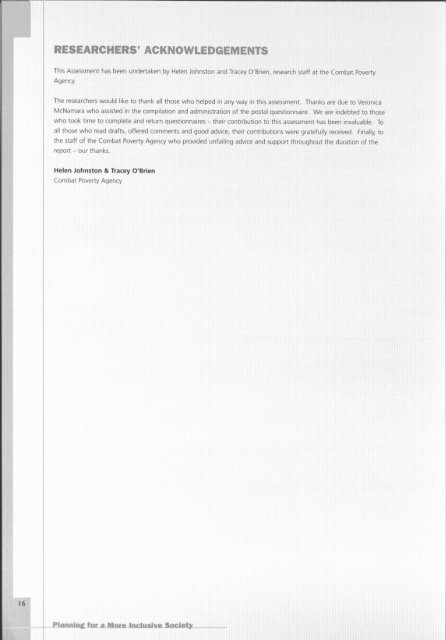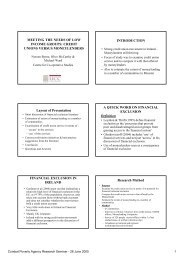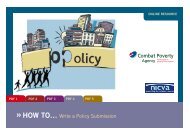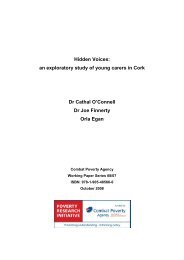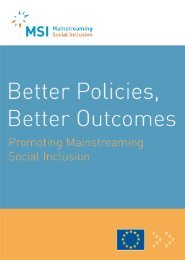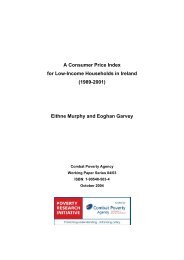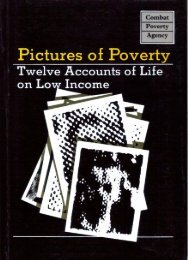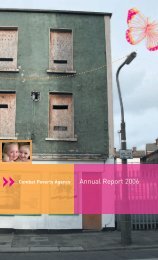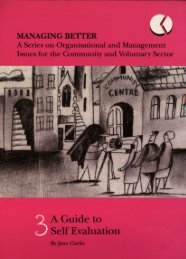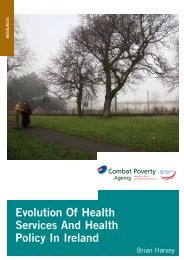Planning for a More Inclusive Society - Combat Poverty Agency
Planning for a More Inclusive Society - Combat Poverty Agency
Planning for a More Inclusive Society - Combat Poverty Agency
Create successful ePaper yourself
Turn your PDF publications into a flip-book with our unique Google optimized e-Paper software.
IThis Assessme nt has beer 1 undertaken by Helen Johnston ; 3nd Tracey I 3'Brien. research staff at the <strong>Combat</strong> <strong>Poverty</strong><strong>Agency</strong>.The researchers would like to thank all those who helped in any way in this assessment. Thanks are due to VeronicaMcNamara who assisted in the compilation and administration of the postal questionnaire. We are indebted to thosewho took time to complete and return questionnaires - their contribution to this assessment has been invaluable. Toall those who read drafts, offered comments ar ~d good ad vice, their c ontribution s were gratefully received. Finally, tothe staff of the <strong>Combat</strong> <strong>Poverty</strong> <strong>Agency</strong> who PI rovided unf ailing advic e and supp ort throughout the duration of thereport - our thanks.Helen Johnston & Tracey O'Brien<strong>Combat</strong> <strong>Poverty</strong> <strong>Agency</strong>1 Executive Summary* r i. Far?roduc?ioaThe publication of the National Anti-<strong>Poverty</strong> Strategy(NAPS) report Sharing in Progress in April 1997 was acritical landmark in the development of Irish social andeconomic policy. NAPS set a ten-year target <strong>for</strong> povertyreduction in Ireland and identified five key areas as needingparticular attention in tackling poverty: income adequacy,unemployment, educational disadvantage, urbanconcentrations of poverty and rural poverty.The <strong>Combat</strong> <strong>Poverty</strong> <strong>Agency</strong> has been glven responslbllltyby . the qovernment -<strong>for</strong> overseelnq an evaluation of theNAPS process, which will include consideration of theviews and experience of the community and voluntarysector. It will present the results of the evaluation to NAPSInter-Departmental Policy Committee (IDPC).This assessment <strong>for</strong>ms part of the <strong>Combat</strong> <strong>Poverty</strong><strong>Agency</strong>'s role in the evaluation of NAPS. It sets out tochart progress to date, to assess key achievements,shortcomings and barriers to progress, and on this basisdraws conclusions on the issues to be addressed in thefuture implementation of NAPS. The assessment draws ondata and material available since the introduction of NAPS:on research reports produced by the ESRI, Monitoring<strong>Poverty</strong> Trends in particular, and on the Social inclusionStrategy: Annual Report of the Inter-Departmental PolicyCommittee 1998199. The assessment also contalns ananalysis of Dail Debates on NAPS and press coverage ofthe Strategy. Records of meetings and other similardocumentation are also drawn upon.The National Economic and Social Forum (NESF) also has arole in monitoring NAPS. The NESF was re-constituted in1998 and is currently considering the nature of its role inrelation to the Strategy. Given its representative structureand focus on policy analysis and monitoring, ~t would seemto have a key role in assessing major social policy Initiatives,such as NAPS. Its fourth pillar will have an importantcontribution to make in this regard.The development of the National Anti-<strong>Poverty</strong> Strategyinvolved an extensive consultation exercise. In undertakingthis assessment it was decided that it would be useful togarner the views of a range of people who had beeninvolved in the development of NAPS through a postalquestionnaire survey Questionnaires were Issued to thecommunity and voluntary sector, to the other soclalpartners, to the statutory sector, to researchers andacademics, to polltlcal advisers, to the media and to localgovernment groups. The questlonnalre responses provldeextremely valuable instghts Into the lmplementatlon ofNAPS to date and how it is seen as a tool to tackle povertyand exclusion in Ireland.NAPS is a ten-year strategy, with 2002 marking the midwaypoint. Further evaluatlon of the Strategy should worktowards producing a substantial mid-term report on itsachievements to 2002. The new partnership agreement,the Partnership <strong>for</strong> Prosperity and Fairness should seek toachieve its objectives by end 2002 -the mid-way perlod<strong>for</strong> NAPS and the end of the partnership agreement.I),. Economic and %cia!Cantex?Since 1997, when NAPS was first introduced, Ireland hasexperienced unprecedented economic growth, Theof this economic growth have been a substantial fall inunemployment, including long-term unemployment, whichis known to be a key cause of poverty. Secondly, thenumbers of those in consistent poverty had substantiallyfallen, to under 10% of the population in 1997.Reductions in unemployment and poverty which might onlyhave seemed aspirational In the early 1990s, have nowbeen achieved. So the context In which NAPS is operatinghas changed, bringing with it new issues and challenges.One such challenge is that the nature of poverty ischanging. While consistent poverty is falling, Incomeinequality is increasing as the gap widens between those inwork and those not in work. This increase in relativeincome poverty may have broader lmpl~cat~ons over thelonger term. The challenge <strong>for</strong> NAPS, in the currentfavourable macro environment, is to tackle both theremaining consistent poverty and to address increasingincome inequalities.The changlng nature of poverty may have other~mpl~cat~ons whlch requlre attention Other emerglngIssues arewhlle many long-term unemployed people have foundwork, there rernalns a group of very long-termunemployed people who have not yet been able toavall of the Increased employment opportun~t~es,the rlsk of poverty <strong>for</strong> older people, particularly olderwomen, has Increased,whlle stdl relatively small, there 1s an tnrrpaslnq rlsk ofpoverty <strong>for</strong> low pald employees.large famllles and rhlldren, In partlrular, cont~ni~e tohave a hlgh rlsk of poverty,people wlth dlsabllltles contlnue to have a hlgtl rlsk ofpoverty.vulnerable groups such as Travellers, people who arePlanninc <strong>for</strong> a Mare <strong>Inclusive</strong> <strong>Society</strong> . . -.


